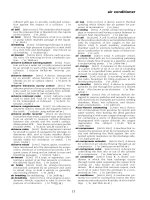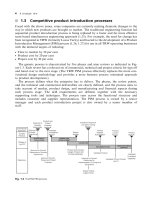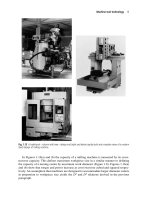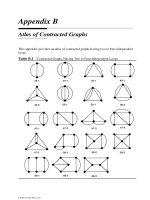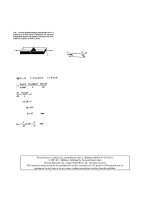Engineering Mechanics - Statics Episode 1 Part 2 pps
Bạn đang xem bản rút gọn của tài liệu. Xem và tải ngay bản đầy đủ của tài liệu tại đây (416.2 KB, 40 trang )
Engineering Mechanics - Statics Chapter 2
+
↑
F
Ry
= SF
y
;
F
RY
F
1
−
c
c
2
d
2
+
F
2
cos
φ
()
− F
3
cos
θ
()
+=
F
RX
162.8− N= F
RY
520.9− N=
F
R
F
RX
2
F
RY
2
+= F
R
546 N=
α
atan
F
RY
F
RX
⎛
⎜
⎝
⎞
⎟
⎠
=
α
72.64 deg=
βα
180 deg+=
β
252.6 deg=
Problem 2-35
Three forces act on the bracket. Determine the magnitude and direction
θ
of
F
1
so that the
resultant force is directed along the positive x'
axis and has a magnitude of
F
R
.
Units Used:
kN 10
3
N=
Given:
F
R
1kN=
F
2
450 N=
F
3
200 N=
α
45 deg=
β
30 deg=
Solution:
+
→
F
Rx
= SF
x
;
F
R
cos
β
()
F
3
F
2
cos
α
()
+ F
1
cos
θβ
+
()
+=
+
↑
F
Ry
= SF
y
;
F
R
− sin
β
()
F
2
sin
α
()
F
1
sin
θβ
+
()
−=
41
© 2007 R. C. Hibbeler. Published by Pearson Education, Inc., Upper Saddle River, NJ. All rights reserved.
This material is protected under all copyright laws as they currently exist. No portion of this material may
be reproduced, in any form or by any means, without permission in writing from the publisher.
Engineering Mechanics - Statics Chapter 2
F
1
cos
θβ
+
()
F
R
cos
β
()
F
3
− F
2
cos
α
()
−=
F
1
sin
θβ
+
()
F
2
sin
α
()
F
R
sin
β
()
+=
θ
atan
F
2
sin
α
()
F
R
sin
β
()
+
F
R
cos
β
()
F
3
− F
2
cos
α
()
−
⎛
⎜
⎝
⎞
⎟
⎠
β
−=
θ
37deg=
F
1
F
R
cos
β
()
F
3
− F
2
cos
α
()
−
()
2
F
2
sin
α
()
F
R
sin
β
()
+
()
2
+=
F
1
889 N=
Problem 2-36
Determine the magnitude and direction, measured counterclockwise from the x
'
axis, of the
resultant force of the three forces acting on the bracket.
Given:
F
1
300 N=
F
2
450 N=
F
3
200 N=
α
45 deg=
β
30 deg=
θ
20 deg=
Solution:
F
Rx
F
1
cos
θβ
+
()
F
3
+ F
2
cos
α
()
+= F
Rx
711.03 N=
F
Ry
F
1
− sin
θβ
+
()
F
2
sin
α
()
+= F
Ry
88.38 N=
42
© 2007 R. C. Hibbeler. Published by Pearson Education, Inc., Upper Saddle River, NJ. All rights reserved.
This material is protected under all copyright laws as they currently exist. No portion of this material may
be reproduced, in any form or by any means, without permission in writing from the publisher.
Engineering Mechanics - Statics Chapter 2
F
R
F
Rx
2
F
Ry
2
+= F
R
717 N=
φ
(angle from x axis)
φ
atan
F
Ry
F
Rx
⎛
⎜
⎝
⎞
⎟
⎠
=
φ
7.1 deg=
φ
'
(angle from x' axis)
φ
'
βφ
+=
φ
' 37.1deg=
Problem 2-37
Determine the magnitude of the resultant force and its direction, measured counterclockwise
from the positive x axis.
Given:
F
1
800 N=
F
2
600 N=
θ
40 deg=
c 12=
d 5=
Solution:
+
→
F
Rx
=
Σ
F
x
;
F
Rx
F
1
cos
θ
()
F
2
c
c
2
d
2
+
⎛
⎜
⎝
⎞
⎟
⎠
−= F
Rx
59 N=
+
↑
F
Ry
=
Σ
F
y
;
F
Ry
F
1
sin
θ
()
F
2
d
c
2
d
2
+
⎛
⎜
⎝
⎞
⎟
⎠
+= F
Ry
745 N=
F
R
F
Rx
2
F
Ry
2
+= F
R
747 N=
43
© 2007 R. C. Hibbeler. Published by Pearson Education, Inc., Upper Saddle River, NJ. All rights reserved.
This material is protected under all copyright laws as they currently exist. No portion of this material may
be reproduced, in any form or by any means, without permission in writing from the publisher.
Engineering Mechanics - Statics Chapter 2
θ
atan
F
Ry
F
Rx
⎛
⎜
⎝
⎞
⎟
⎠
=
θ
85.5 deg=
Problem 2-38
Determine the magnitude of the resultant force and its direction, measured counterclockwise
from the positive x axis.
Units Used:
kN 10
3
N=
Given:
F
1
30 kN=
F
2
26 kN=
θ
30 deg=
c 5=
d 12=
Solution:
+
→
F
Rx
=
Σ
F
x
;
F
Rx
F
1
− sin
θ
()
c
c
2
d
2
+
⎛
⎜
⎝
⎞
⎟
⎠
F
2
−= F
Rx
25− kN=
+
↑
F
Ry
=
Σ
F
y
;
F
Ry
F
1
− cos
θ
()
d
c
2
d
2
+
⎛
⎜
⎝
⎞
⎟
⎠
F
2
+= F
Ry
2− kN=
F
R
F
Rx
2
F
Ry
2
+= F
R
25.1 kN=
φ
atan
F
Ry
F
Rx
⎛
⎜
⎝
⎞
⎟
⎠
=
φ
4.5 deg=
β
180 deg
φ
+=
β
184.5 deg=
44
© 2007 R. C. Hibbeler. Published by Pearson Education, Inc., Upper Saddle River, NJ. All rights reserved.
This material is protected under all copyright laws as they currently exist. No portion of this material may
be reproduced, in any form or by any means, without permission in writing from the publisher.
Engineering Mechanics - Statics Chapter 2
Problem 2-39
Determine the magnitude of the resultant force and its direction measured counterclockwise
from the positive x axis.
Given:
F
1
60 lb=
F
2
70 lb=
F
3
50 lb=
θ
1
60 deg=
θ
2
45 deg=
c 1=
d 1=
Solution:
θ
3
atan
d
c
⎛
⎜
⎝
⎞
⎟
⎠
=
F
Rx
F
1
− cos
θ
3
()
F
2
sin
θ
1
()
−= F
Rx
103− lb=
F
Ry
F
1
sin
θ
3
()
F
2
cos
θ
1
()
− F
3
−= F
Ry
42.6− lb=
F
R
F
Rx
2
F
Ry
2
+= F
R
111.5 lb=
θ
180 deg atan
F
Ry
F
Rx
⎛
⎜
⎝
⎞
⎟
⎠
+=
θ
202deg=
Problem 2-40
Determine the magnitude of the resultant force
F
R
= F
1
+ F
2
and its direction, measured
counterclockwise from the positive x axis by summing the rectangular or x, y components
of the forces to obtain the resultant force.
45
© 2007 R. C. Hibbeler. Published by Pearson Education, Inc., Upper Saddle River, NJ. All rights reserved.
This material is protected under all copyright laws as they currently exist. No portion of this material may
be reproduced, in any form or by any means, without permission in writing from the publisher.
Engineering Mechanics - Statics Chapter 2
Given:
F
1
600 N=
F
2
800 N=
F
3
450 N=
θ
1
60 deg=
θ
2
45 deg=
θ
3
75 deg=
Solution:
+
→
F
Rx
=
Σ
F
x
;
F
Rx
F
1
cos
θ
2
()
F
2
sin
θ
1
()
−= F
Rx
268.556− N=
+
↑
F
Ry
=
Σ
F
y
;
F
Ry
F
1
sin
θ
2
()
F
2
cos
θ
1
()
+= F
Ry
824.264 N=
F
R
F
Rx
2
F
Ry
2
+= F
R
867 N=
θ
180 deg atan
F
Ry
F
Rx
⎛
⎜
⎝
⎞
⎟
⎠
−=
θ
108deg=
Problem 2-41
Determine the magnitude and direction of the resultant
F
R
=
F
1
+
F
2
+
F
3
of the three forces
by summing the rectangular or x, y components of the forces to obtain the resultant force.
Given:
F
1
30 N=
F
2
20 N=
46
© 2007 R. C. Hibbeler. Published by Pearson Education, Inc., Upper Saddle River, NJ. All rights reserved.
This material is protected under all copyright laws as they currently exist. No portion of this material may
be reproduced, in any form or by any means, without permission in writing from the publisher.
Engineering Mechanics - Statics Chapter 2
F
3
50 N=
θ
20 deg=
c 3=
d 4=
Solution:
F
Rx
F
1
−
d
c
2
d
2
+
⎛
⎜
⎝
⎞
⎟
⎠
F
2
sin
θ
()()
− F
3
+= F
Rx
19.2 N=
F
Ry
F
1
c
c
2
d
2
+
⎛
⎜
⎝
⎞
⎟
⎠
F
2
cos
θ
()
−= F
Ry
0.8− N=
F
R
F
Rx
2
F
Ry
2
+= F
R
19.2 N=
θ
atan
F
Ry
−
F
Rx
⎛
⎜
⎝
⎞
⎟
⎠
=
θ
2.4 deg=
Problem 2-42
Determine the magnitude and orientation, measured counterclockwise from the positive y axis, of the
resultant force acting on the bracket.
Given:
F
A
700 N=
47
© 2007 R. C. Hibbeler. Published by Pearson Education, Inc., Upper Saddle River, NJ. All rights reserved.
This material is protected under all copyright laws as they currently exist. No portion of this material may
be reproduced, in any form or by any means, without permission in writing from the publisher.
Engineering Mechanics - Statics Chapter 2
F
B
600 N=
θ
20 deg=
φ
30 deg=
Solution:
Scalar Notation: Suming the force components algebraically, we have
F
Rx
=
Σ
F
x
;
F
Rx
F
A
sin
φ
()
F
B
cos
θ
()
−=
F
Rx
213.8− N=
F
Ry
=
Σ
F
y
;
F
Ry
F
A
cos
φ
()
F
B
sin
θ
()
+=
F
Ry
811.4 N=
The magnitude of the resultant force F
R
is
F
R
F
Rx
2
F
Ry
2
+=
F
R
839 N=
The directional angle
θ
measured counterclockwise
from the positive x axis is
θ
atan
F
Rx
F
Ry
⎛
⎜
⎝
⎞
⎟
⎠
=
θ
14.8 deg=
Problem 2-43
Determine the magnitude and direction, measured counterclockwise from the positive x'
axis, of the resultant force of the three forces acting on the bracket.
Given:
F
1
300 N=
48
© 2007 R. C. Hibbeler. Published by Pearson Education, Inc., Upper Saddle River, NJ. All rights reserved.
This material is protected under all copyright laws as they currently exist. No portion of this material may
be reproduced, in any form or by any means, without permission in writing from the publisher.
Engineering Mechanics - Statics Chapter 2
F
2
200 N=
F
3
180 N=
θ
10 deg=
θ
1
60 deg=
c 5=
d 12=
Solution:
+
→
F
Rx
=
Σ
F
x
;
F
Rx
F
1
sin
θ
1
θ
+
()
d
c
2
d
2
+
⎛
⎜
⎝
⎞
⎟
⎠
F
3
−= F
Rx
115.8 N=
+
↑
F
Ry
=
Σ
F
y
;
F
Ry
F
1
cos
θ
1
θ
+
()
F
2
+
c
c
2
d
2
+
⎛
⎜
⎝
⎞
⎟
⎠
F
3
+= F
Ry
371.8 N=
F
R
F
Rx
2
F
Ry
2
+= F
R
389 N=
φ
atan
F
Ry
F
Rx
⎛
⎜
⎝
⎞
⎟
⎠
=
φ
72.7 deg=
ψφ
90 deg
θ
1
−
()
−=
ψ
42.7 deg=
Problem 2-44
Determine the x and y components of
F
1
and
F
2
.
49
© 2007 R. C. Hibbeler. Published by Pearson Education, Inc., Upper Saddle River, NJ. All rights reserved.
This material is protected under all copyright laws as they currently exist. No portion of this material may
be reproduced, in any form or by any means, without permission in writing from the publisher.
Engineering Mechanics - Statics Chapter 2
F
1
200 N=
F
2
150 N=
θ
45 deg=
φ
30 deg=
Solution:
F
1x
F
1
sin
θ
()
=
F
1x
141.4 N=
F
1y
F
1
cos
θ
()
=
F
1y
141.4 N=
F
2x
F
2
− cos
φ
()
=
F
2x
129.9− N=
F
2y
F
2
sin
φ
()
=
F
2y
75 N=
Problem 2-45
Determine the magnitude of the resultant force and its direction, measured counterclockwise
from the positive x axis.
Given:
F
1
200 N=
F
2
150 N=
θ
45 deg=
φ
30 deg=
50
Given:
© 2007 R. C. Hibbeler. Published by Pearson Education, Inc., Upper Saddle River, NJ. All rights reserved.
This material is protected under all copyright laws as they currently exist. No portion of this material may
be reproduced, in any form or by any means, without permission in writing from the publisher.
Engineering Mechanics - Statics Chapter 2
Solution:
+
→
F
Rx
=
Σ
F
x
;
F
Rx
F
1
sin
θ
()
F
2
cos
φ
()
−= F
Rx
11.5 N=
+
↑
F
Ry
=
Σ
F
y
;
F
Ry
F
1
cos
θ
()
F
2
sin
φ
()
+= F
Ry
216.4 N=
FF
Rx
2
F
Ry
2
+= F 217 N=
β
atan
F
Ry
F
Rx
⎛
⎜
⎝
⎞
⎟
⎠
=
β
87deg=
Problem 2-46
Determine the x and y components of each force acting on the gusset plate of the bridge truss.
Given:
F
1
200 lb= c 3=
F
2
400 lb= d 4=
F
3
300 lb= e 3=
F
4
300 lb= f 4=
Solution:
F
1x
F
1
−=
F
1x
200− lb=
F
1y
0lb=
F
2x
F
2
d
c
2
d
2
+
⎛
⎜
⎝
⎞
⎟
⎠
=
F
2x
320lb=
F
2y
F
2
−
c
c
2
d
2
+
⎛
⎜
⎝
⎞
⎟
⎠
=
F
2y
240− lb=
F
3x
F
3
e
e
2
f
2
+
⎛
⎜
⎝
⎞
⎟
⎠
=
51
© 2007 R. C. Hibbeler. Published by Pearson Education, Inc., Upper Saddle River, NJ. All rights reserved.
This material is protected under all copyright laws as they currently exist. No portion of this material may
be reproduced, in any form or by any means, without permission in writing from the publisher.
Engineering Mechanics - Statics Chapter 2
F
3x
180lb=
F
3y
F
3
f
e
2
f
2
+
⎛
⎜
⎝
⎞
⎟
⎠
=
F
3y
240lb=
F
4x
F
4
−=
F
4x
300− lb=
F
4y
0lb=
Problem 2-47
Determine the magnitude of the resultant force and its direction measured clockwise from
the positive x axis.
Units Used:
kN 10
3
N=
Given:
F
1
20 kN=
F
2
40 kN=
F
3
50 kN=
θ
60 deg=
c 1=
d 1=
e 3=
f 4=
Solution:
+
→
F
Rx
=
Σ
F
x
;
F
Rx
F
3
f
e
2
f
2
+
⎛
⎜
⎝
⎞
⎟
⎠
F
2
d
c
2
d
2
+
⎛
⎜
⎝
⎞
⎟
⎠
+ F
1
cos
θ
()
−=
F
Rx
58.28 kN=
52
© 2007 R. C. Hibbeler. Published by Pearson Education, Inc., Upper Saddle River, NJ. All rights reserved.
This material is protected under all copyright laws as they currently exist. No portion of this material may
be reproduced, in any form or by any means, without permission in writing from the publisher.
Engineering Mechanics - Statics Chapter 2
+
↑
F
Ry
=
Σ
F
y
;
F
Ry
F
3
e
e
2
f
2
+
⎛
⎜
⎝
⎞
⎟
⎠
F
2
c
c
2
d
2
+
⎛
⎜
⎝
⎞
⎟
⎠
− F
1
sin
θ
()
−=
F
Ry
15.6− kN=
FF
Rx
2
F
Ry
2
+=
F 60.3 kN=
θ
atan
F
Ry
F
Rx
⎛
⎜
⎝
⎞
⎟
⎠
=
θ
15deg=
Problem 2-48
Three forces act on the bracket. Determine the magnitude and direction
θ
of
F
1
so that the
resultant force is directed along the positive x' axis and has magnitude
F
R
.
Given:
F
2
200 N=
F
3
180 N=
θ
1
60 deg=
F
R
800 N=
c 5=
d 12=
Solution:
Initial Guesses:
F
1
100 N=
θ
10 deg=
Given
+
→
F
Rx
=
Σ
F
x
;
F
R
sin
θ
1
()
F
1
sin
θ
1
θ
+
()
d
c
2
d
2
+
⎛
⎜
⎝
⎞
⎟
⎠
F
3
−=
53
© 2007 R. C. Hibbeler. Published by Pearson Education, Inc., Upper Saddle River, NJ. All rights reserved.
This material is protected under all copyright laws as they currently exist. No portion of this material may
be reproduced, in any form or by any means, without permission in writing from the publisher.
Engineering Mechanics - Statics Chapter 2
+
↑
F
R
cos
θ
1
()()
F
1
cos
θ
1
θ
+
()
F
2
+
c
c
2
d
2
+
⎛
⎜
⎝
⎞
⎟
⎠
F
3
+=
F
Ry
=
Σ
F
y
;
F
1
θ
⎛
⎜
⎝
⎞
⎟
⎠
Find F
1
θ
,
()
=
F
1
869 N=
θ
21.3 deg=
Problem 2-49
Determine the magnitude and direction, measured counterclockwise from the positive x'
axis, of the resultant force acting on the bracket.
Given:
F
1
300 N=
F
2
200 N=
F
3
180 N=
θ
1
60 deg=
θ
10 deg=
c 5=
d 12=
Solution:
Guesses
F
Rx
100 N= F
Ry
100 N=
Given
+
→
F
Rx
=
Σ
F
x
;
F
Rx
F
1
sin
θ
1
θ
+
()
d
c
2
d
2
+
⎛
⎜
⎝
⎞
⎟
⎠
F
3
−=
+
↑
F
Ry
=
Σ
F
y
;
F
Ry
F
1
cos
θ
1
θ
+
()
F
2
+
c
c
2
d
2
+
⎛
⎜
⎝
⎞
⎟
⎠
F
3
()
+=
54
© 2007 R. C. Hibbeler. Published by Pearson Education, Inc., Upper Saddle River, NJ. All rights reserved.
This material is protected under all copyright laws as they currently exist. No portion of this material may
be reproduced, in any form or by any means, without permission in writing from the publisher.
Engineering Mechanics - Statics Chapter 2
F
Rx
F
Ry
⎛
⎜
⎝
⎞
⎟
⎠
Find F
Rx
F
Ry
,
()
=
F
Rx
F
Ry
⎛
⎜
⎝
⎞
⎟
⎠
115.8
371.8
⎛
⎜
⎝
⎞
⎟
⎠
N=
F
R
F
Rx
2
F
Ry
2
+= F
R
389 N=
φ
atan
F
Ry
F
Rx
⎛
⎜
⎝
⎞
⎟
⎠
=
φ
72.7 deg=
φ
'
φ
90 deg
θ
1
−
()
−
⎡
⎣
⎤
⎦
=
φ
' 42.7deg=
Problem 2-50
Express each of the three forces acting on the column in Cartesian vector form and compute
the magnitude of the resultant force.
Given:
F
1
150 lb=
θ
60 deg=
F
2
275 lb= c 4=
F
3
75 lb= d 3=
Solution:
Find the components of each force.
F
1x
F
1
d
c
2
d
2
+
⎛
⎜
⎝
⎞
⎟
⎠
= F
1y
F
1
c−
c
2
d
2
+
⎛
⎜
⎝
⎞
⎟
⎠
=
F
1v
F
1x
F
1y
⎛
⎜
⎝
⎞
⎟
⎠
= F
1v
90
120−
⎛
⎜
⎝
⎞
⎟
⎠
lb=
F
2x
0lb= F
2y
F
2
−=
F
2v
F
2x
F
2y
⎛
⎜
⎝
⎞
⎟
⎠
= F
2v
0
275−
⎛
⎜
⎝
⎞
⎟
⎠
lb=
55
© 2007 R. C. Hibbeler. Published by Pearson Education, Inc., Upper Saddle River, NJ. All rights reserved.
This material is protected under all copyright laws as they currently exist. No portion of this material may
be reproduced, in any form or by any means, without permission in writing from the publisher.
Engineering Mechanics - Statics Chapter 2
F
3x
F
3
− cos
θ
()
= F
3y
F
3
− sin
θ
()
=
F
3v
F
3x
F
3y
⎛
⎜
⎝
⎞
⎟
⎠
= F
3v
37.5−
65−
⎛
⎜
⎝
⎞
⎟
⎠
lb=
Now find the magnitude of the resultant force.
F
R
F
1v
F
2v
+ F
3v
+= F
R
462.9 lb=
Problem 2-51
Determine the magnitude of force
F
so that the resultant
F
R
of the three forces is as small
as possible. What is the minimum magnitude of
F
R
?
Units Used:
kN 1000 N=
Given:
F
1
5kN=
F
2
4kN=
θ
30 deg=
Solution:
Scalar Notation:
Suming the force components
algebrically, we have
+
→
F
Rx
=
Σ
F
x
;
F
Rx
F
1
F sin
θ
()
−=
+
↑
F
Ry
=
Σ
F
y
;
F
Ry
F cos
θ
()
F
2
−=
The magnitude of the resultant force
F
R
is
F
R
F
Rx
2
F
Ry
2
+= F
1
F sin
θ
()
−
()
2
F cos
θ
()
F
2
−
()
2
+=
56
© 2007 R. C. Hibbeler. Published by Pearson Education, Inc., Upper Saddle River, NJ. All rights reserved.
This material is protected under all copyright laws as they currently exist. No portion of this material may
be reproduced, in any form or by any means, without permission in writing from the publisher.
Engineering Mechanics - Statics Chapter 2
F
R
2
F
1
2
F
2
2
+ F
2
+ 2FF
1
sin
θ
()
− 2F
2
Fcos
θ
()
−=
2F
R
dF
R
dF
2F 2F
1
sin
θ
()
− 2F
2
cos
θ
()
−=
If F is a minimum, then
dF
R
dF
0=
⎛
⎜
⎝
⎞
⎟
⎠
FF
1
sin
θ
()
F
2
cos
θ
()
+= F 5.96 kN=
F
R
F
1
F sin
θ
()
−
()
2
F cos
θ
()
F
2
−
()
2
+= F
R
2.3 kN=
Problem 2-52
Express each of the three forces acting on the bracket in Cartesian vector form with respect
to the x and y axes. Determine the magnitude and direction
θ
of
F
1
so that the resultant force
is directed along the positive x
'
axis and has magnitude
F
R
.
Units Used:
kN 1000 N=
Given:
F
R
600 N=
F
2
350 N=
F
3
100 N=
φ
30 deg=
Solution:
F
2v
F
2
0
⎛
⎜
⎝
⎞
⎟
⎠
= F
3v
0
F
3
−
⎛
⎜
⎝
⎞
⎟
⎠
=
F
1v
F
1
cos
θ
()
F
1
sin
θ
()
⎛
⎜
⎝
⎞
⎟
⎠
= F
2v
350
0
⎛
⎜
⎝
⎞
⎟
⎠
N= F
3v
0
100−
⎛
⎜
⎝
⎞
⎟
⎠
N=
57
© 2007 R. C. Hibbeler. Published by Pearson Education, Inc., Upper Saddle River, NJ. All rights reserved.
This material is protected under all copyright laws as they currently exist. No portion of this material may
be reproduced, in any form or by any means, without permission in writing from the publisher.
Engineering Mechanics - Statics Chapter 2
The initial guesses
:
F
1
20 N=
θ
10 deg=
Given
F
1
cos
θ
()
F
1
sin
θ
()
⎛
⎜
⎝
⎞
⎟
⎠
F
2v
+ F
3v
+
F
R
cos
φ
()
F
R
sin
φ
()
⎛
⎜
⎝
⎞
⎟
⎠
=
F
1
θ
⎛
⎜
⎝
⎞
⎟
⎠
Find F
1
θ
,
()
= F
1
434.5 N=
θ
67deg=
Problem 2-53
The three concurrent forces acting on the post produce a resultant force
F
R
= 0. If
F
2
= (1/2)
F
1
,
and
F
1
is to be 90° from
F
2
as shown, determine the required magnitude
F
3
expressed in terms
of
F
1
and the angle
θ
.
Solution: Use the primed coordiates.
Σ
F
Rx
= 0
F
3
cos
θ
90 deg−
()
F
1
− 0=
Σ
F
Ry
= 0
F
3
− sin
θ
90 deg−
()
F
2
+ 0=
tan
θ
90 deg−
()
F
2
F
1
=
1
2
=
θ
90 deg atan
1
2
⎛
⎜
⎝
⎞
⎟
⎠
+=
θ
117deg=
k
1
cos
θ
90 deg−
()
=
k 1.1= F
3
kF
1
=
58
© 2007 R. C. Hibbeler. Published by Pearson Education, Inc., Upper Saddle River, NJ. All rights reserved.
This material is protected under all copyright laws as they currently exist. No portion of this material may
be reproduced, in any form or by any means, without permission in writing from the publisher.
Engineering Mechanics - Statics Chapter 2
Problem 2-54
Three forces act on the bracket. Determine the magnitude and orientation
θ
of
F
2
so that the
resultant force is directed along the positive u axis and has magnitude F
R
.
Given:
F
R
50 lb=
F
1
80 lb=
F
3
52 lb=
φ
25 deg=
c 12=
d 5=
Solution:
Guesses
F
2
1lb=
θ
120 deg=
Given
F
R
cos
φ
()
F
1
F
2
cos
φθ
+
()
+
d
c
2
d
2
+
⎛
⎜
⎝
⎞
⎟
⎠
F
3
+=
F
R
− sin
φ
()
F
2
− sin
φθ
+
()
c
c
2
d
2
+
⎛
⎜
⎝
⎞
⎟
⎠
F
3
+=
F
2
θ
⎛
⎜
⎝
⎞
⎟
⎠
Find F
2
θ
,
()
= F
2
88.1 lb=
θ
103.3 deg=
59
© 2007 R. C. Hibbeler. Published by Pearson Education, Inc., Upper Saddle River, NJ. All rights reserved.
This material is protected under all copyright laws as they currently exist. No portion of this material may
be reproduced, in any form or by any means, without permission in writing from the publisher.
Engineering Mechanics - Statics Chapter 2
Problem 2-55
Determine the magnitude and orientation, measured clockwise from the positive x axis, of
the resultant force of the three forces acting on the bracket.
Given:
F
1
80 lb=
F
2
150 lb=
F
3
52lb=
θ
55 deg=
φ
25 deg=
c 12 m=
d 5m=
Solution:
F
Rx
F
1
F
3
d
c
2
d
2
+
⎛
⎜
⎝
⎞
⎟
⎠
+ F
2
cos
θφ
+
()
+= F
Rx
126.05 lb=
F
Ry
F
3
c
c
2
d
2
+
⎛
⎜
⎝
⎞
⎟
⎠
F
2
sin
θφ
+
()
−= F
Ry
99.7− lb=
F
R
F
Rx
2
F
Ry
2
+= F
R
161lb=
β
atan
F
Ry
F
Rx
⎛
⎜
⎝
⎞
⎟
⎠
=
β
38.3 deg=
Problem 2-56
Three forces act on the ring. Determine the range of values for the magnitude of
P
so that the
magnitude of the resultant force does not exceed F. Force
P
is always directed to the right.
60
© 2007 R. C. Hibbeler. Published by Pearson Education, Inc., Upper Saddle River, NJ. All rights reserved.
This material is protected under all copyright laws as they currently exist. No portion of this material may
be reproduced, in any form or by any means, without permission in writing from the publisher.
Engineering Mechanics - Statics Chapter 2
kN 10
3
N=
Given:
F 2500 N=
F
1
1500 N=
F
2
600 N=
θ
1
60 deg=
θ
2
45 deg=
Solution:
Initial Guesses:
F
Rx
100 N= F
Ry
100 N= P 100 N=
Given
+
→
F
Rx
=
Σ
F
x
;
F
Rx
PF
2
cos
θ
2
()
+ F
1
cos
θ
1
θ
2
+
()
+=
+
↑
F
Ry
=
Σ
F
y
;
F
Ry
F
2
sin
θ
2
()
F
1
sin
θ
1
θ
2
+
()
+=
FF
Rx
2
F
Ry
2
+=
F
Rx
F
Ry
P
max
⎛
⎜
⎜
⎜
⎝
⎞
⎟
⎟
⎟
⎠
Find F
Rx
F
Ry
, P,
()
= P
max
1.6 kN=
Initial Guesses:
F
Rx
100− N= F
Ry
100 N=
P 2000− N=
Given
+
→
F
Rx
=
Σ
F
x
;
F
Rx
PF
2
cos
θ
2
()
+ F
1
cos
θ
1
θ
2
+
()
+=
+
↑
F
Ry
=
Σ
F
y
;
F
Ry
F
2
sin
θ
2
()
F
1
sin
θ
1
θ
2
+
()
+=
FF
Rx
2
F
Ry
2
+=
F
Rx
F
Ry
P
min
⎛
⎜
⎜
⎜
⎝
⎞
⎟
⎟
⎟
⎠
Find F
Rx
F
Ry
, P,
()
= P
min
1.7− kN=
61
Units Used:
© 2007 R. C. Hibbeler. Published by Pearson Education, Inc., Upper Saddle River, NJ. All rights reserved.
This material is protected under all copyright laws as they currently exist. No portion of this material may
be reproduced, in any form or by any means, without permission in writing from the publisher.
Engineering Mechanics - Statics Chapter 2
Since P > 0 we conclude that 0 <= P <=
P
max
1.6 kN
=
Problem 2-57
Determine the magnitude and coordinate direction angles of
F
1
and
F
2
. Sketch each force
on an x, y, z reference.
Given:
F
1
60
50−
40
⎛
⎜
⎜
⎝
⎞
⎟
⎟
⎠
N=
F
2
40−
85−
30
⎛
⎜
⎜
⎝
⎞
⎟
⎟
⎠
N=
Solution:
F
1
87.7 N=
α
1
β
1
γ
1
⎛
⎜
⎜
⎜
⎝
⎞
⎟
⎟
⎟
⎠
acos
F
1
F
1
⎛
⎜
⎝
⎞
⎟
⎠
=
α
1
β
1
γ
1
⎛
⎜
⎜
⎜
⎝
⎞
⎟
⎟
⎟
⎠
46.9
124.7
62.9
⎛
⎜
⎜
⎝
⎞
⎟
⎟
⎠
deg=
F
2
98.6 N=
62
© 2007 R. C. Hibbeler. Published by Pearson Education, Inc., Upper Saddle River, NJ. All rights reserved.
This material is protected under all copyright laws as they currently exist. No portion of this material may
be reproduced, in any form or by any means, without permission in writing from the publisher.
Engineering Mechanics - Statics Chapter 2
α
2
β
2
γ
2
⎛
⎜
⎜
⎜
⎝
⎞
⎟
⎟
⎟
⎠
acos
F
2
F
2
⎛
⎜
⎝
⎞
⎟
⎠
=
α
2
β
2
γ
2
⎛
⎜
⎜
⎜
⎝
⎞
⎟
⎟
⎟
⎠
113.9
149.5
72.3
⎛
⎜
⎜
⎝
⎞
⎟
⎟
⎠
deg=
Problem 2-58
Express each force in Cartesian vector form.
Units Used:
kN 10
3
N=
Given:
F
1
5kN=
F
2
2kN=
θ
1
60 deg=
θ
2
60 deg=
θ
3
45 deg=
Solution:
F
1v
F
1
cos
θ
2
()
cos
θ
3
()
cos
θ
1
()
⎛
⎜
⎜
⎜
⎝
⎞
⎟
⎟
⎟
⎠
= F
1v
2.5
3.5
2.5
⎛
⎜
⎜
⎝
⎞
⎟
⎟
⎠
kN=
F
2v
F
2
0
1−
0
⎛
⎜
⎜
⎝
⎞
⎟
⎟
⎠
= F
2v
0
2−
0
⎛
⎜
⎜
⎝
⎞
⎟
⎟
⎠
kN=
63
© 2007 R. C. Hibbeler. Published by Pearson Education, Inc., Upper Saddle River, NJ. All rights reserved.
This material is protected under all copyright laws as they currently exist. No portion of this material may
be reproduced, in any form or by any means, without permission in writing from the publisher.
Engineering Mechanics - Statics Chapter 2
Problem 2-59
Determine the magnitude and coordinate direction angles of the force
F
acting on the stake.
Given:
F
h
40 N=
θ
70 deg=
c 3=
d 4=
Solution:
FF
h
c
2
d
2
+
d
⎛
⎜
⎝
⎞
⎟
⎠
=
F 50 N=
F
x
F
h
cos
θ
()
= F
y
F
h
sin
θ
()
= F
z
c
c
2
d
2
+
⎛
⎜
⎝
⎞
⎟
⎠
F=
F
x
13.7 N= F
y
37.6 N= F
z
30 N=
α
acos
F
x
F
⎛
⎜
⎝
⎞
⎟
⎠
=
β
acos
F
y
F
⎛
⎜
⎝
⎞
⎟
⎠
=
γ
acos
F
z
F
⎛
⎜
⎝
⎞
⎟
⎠
=
α
74.1 deg=
β
41.3 deg=
γ
53.1 deg=
Problem 2-60
Express each force in Cartesian vector form.
64
© 2007 R. C. Hibbeler. Published by Pearson Education, Inc., Upper Saddle River, NJ. All rights reserved.
This material is protected under all copyright laws as they currently exist. No portion of this material may
be reproduced, in any form or by any means, without permission in writing from the publisher.
Engineering Mechanics - Statics Chapter 2
F
1
400 lb=
F
2
600 lb=
θ
1
45 deg=
θ
2
60 deg=
θ
3
60 deg=
θ
4
45 deg=
θ
5
30 deg=
Solution:
F
1v
F
1
cos
θ
2
()
−
cos
θ
3
()
cos
θ
1
()
⎛
⎜
⎜
⎜
⎝
⎞
⎟
⎟
⎟
⎠
= F
1v
200−
200
282.8
⎛
⎜
⎜
⎝
⎞
⎟
⎟
⎠
lb=
F
2v
F
2
cos
θ
5
()
cos
θ
4
()
cos
θ
5
()
sin
θ
4
()
sin
θ
5
()
−
⎛
⎜
⎜
⎜
⎝
⎞
⎟
⎟
⎟
⎠
= F
2v
367.4
367.4
300−
⎛
⎜
⎜
⎝
⎞
⎟
⎟
⎠
lb=
Problem 2-61
The stock S mounted on the lathe is subjected to a
force
F
, which is caused by the die D. Determine the
coordinate direction angle
β
and express the force as
a Cartesian vector.
Given:
F 60 N=
α
60 deg=
γ
30 deg=
65
Given:
© 2007 R. C. Hibbeler. Published by Pearson Education, Inc., Upper Saddle River, NJ. All rights reserved.
This material is protected under all copyright laws as they currently exist. No portion of this material may
be reproduced, in any form or by any means, without permission in writing from the publisher.
